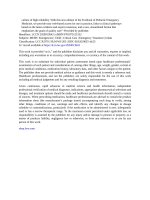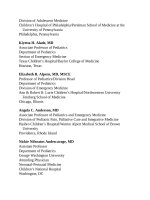Pediatric emergency medicine trisk 1969 1969
Bạn đang xem bản rút gọn của tài liệu. Xem và tải ngay bản đầy đủ của tài liệu tại đây (73.52 KB, 1 trang )
Initial management
Remove from source of current
Cardiopulmonary resuscitation as needed
Provide mechanical ventilation until spontaneous ventilation is adequate
Immobilize neck and spine
Clinical assessment
Neurologic examination (thorough evaluation for possible spinal cord injury)
Peripheral pulses and perfusion and evaluation of the limbs for compartment
syndrome
Oral burns/edema
Chest wall injury
Abdominal distention
Eye or ear trauma
Cutaneous burns or bruises
Laboratory/Imaging determinations
Complete blood cell count
Blood urea nitrogen, creatinine, urinalysis including myoglobin
Electrolytes
Troponin
Electrocardiogram (ECG)
Consider skull, spine, chest, long bone radiographs
Consider computed tomography scan of brain (especially in lightning injuries)
Consider electroencephalogram
Monitoring
Heart rate, ECG, respiratory rate, blood pressure
Management
Maintenance fluids: 5% dextrose in normal saline
Volume expansion in presence of thermal burns or extensive deep tissue injury:
0.9% sodium chloride or lactated Ringer’s solution
Fluid restriction for central nervous system injury
Maintain urine output >1 mL/kg/hr









